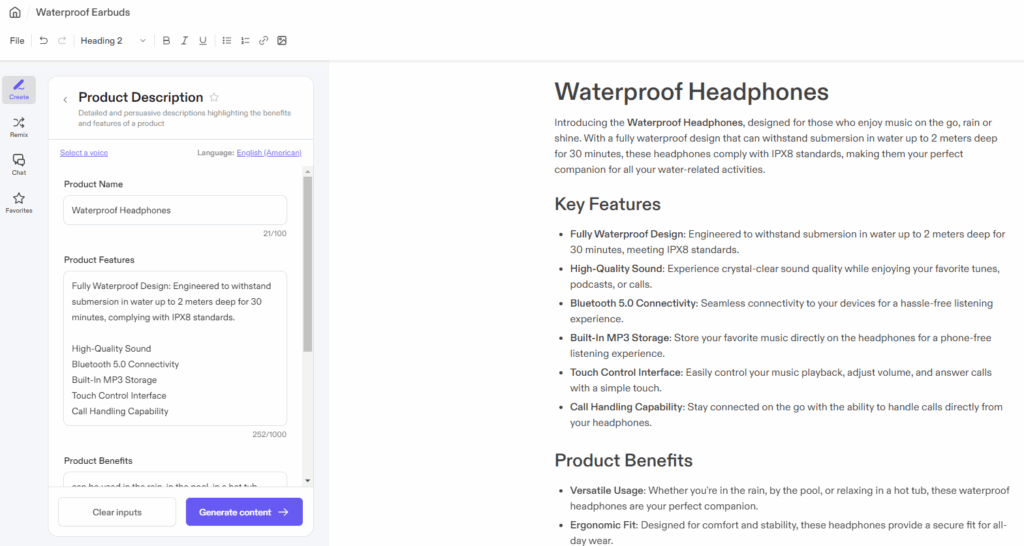Did you know that up to 180 million people use generative AI each day? This rapid adoption isn’t surprising when you consider how AI product descriptions are transforming e-commerce businesses today.
Product descriptions can significantly boost sales while simultaneously improving your website’s search engine optimization (SEO). However, creating them manually is often time-consuming and repetitive, especially for businesses with large inventories. Fortunately, e-commerce product descriptions have become the perfect task for artificial intelligence to handle. With AI-driven tools, businesses can now generate compelling product content that not only informs but also persuades customers to make purchases.
Furthermore, reviews represent a goldmine of data for e-commerce sites, yet many businesses fail to fully harness their potential. AI for product description can analyze these customer insights to create content that truly resonates with shoppers. For businesses that are scaling or rapidly expanding their product range, AI can efficiently manage the increased demand for descriptions.
This article explores how to use AI to write product descriptions that maintain a natural, human tone while driving conversions and improving search visibility. Whether you’re just starting with AI or looking to refine your approach, you’ll discover practical strategies to leverage this powerful technology for your e-commerce business.
Table of Contents
ToggleWhy Use AI for E-Commerce Product Descriptions
E-commerce businesses face a constant challenge when managing product descriptions for large inventories. For a human writer, creating 200 product descriptions typically consumes about 50 hours, making it an ideal candidate for automation.
Save time and reduce manual effort
AI-generated product descriptions dramatically reduce the time needed to create quality content. Instead of spending hours crafting descriptions manually, businesses can generate them in minutes. One marketing professional calculated that using brand-trained AI saves approximately three hours daily, translating to fifteen hours weekly and seventy hours monthly. This efficiency allows teams to redirect their efforts toward strategic tasks like monitoring performance, refining marketing strategies, or developing new products.

Maintain brand voice across large catalogs
Consistency in brand communication builds trust and strengthens identity. AI excels in maintaining a uniform tone and style across all product descriptions, particularly valuable for businesses with extensive catalogs. By training AI using your brand guidelines and voice samples, you create a foundation that ensures all AI-generated content aligns with your established messaging. This approach delivers the remarkable benefit of maintaining consistency without sacrificing scalability.
Improve SEO and search visibility
Product descriptions serve as critical tools for search engine optimization. AI tools naturally incorporate relevant keywords into descriptions, consequently improving your products’ visibility in search results. Optimized AI-generated content helps drive more organic traffic by ranking products higher in search engine results pages. This visibility is essential since customers typically choose between only the top few search results.
Scale content creation efficiently
Perhaps the most significant advantage of AI for e-commerce is the ability to scale content creation. Businesses can generate thousands of descriptions in minutes instead of weeks, making it possible to:
- Launch new products faster to capitalize on market trends
- Expand to global markets with localized content
- Update descriptions quickly when specifications change
- Create multiple variations for different platforms and audiences
The scalability aspect is particularly valuable during inventory expansion, where AI handles increased demand for descriptions without requiring proportional resource increases.
Ultimately, AI product descriptions contribute directly to conversion rates. When customers visit e-commerce stores, they rely heavily on descriptions to understand products and make purchasing decisions. Well-crafted, AI-generated descriptions can therefore directly impact your bottom line.
Top AI Tools for Writing Product Descriptions
Several powerful AI tools now exist to help e-commerce businesses generate high-quality product descriptions. Each offers unique capabilities to enhance your content creation process.
1. Jasper AI
Jasper excels at creating compelling product descriptions with its advanced language processing capabilities. This tool allows users to generate content in 30+ languages while maintaining a consistent brand voice. Additionally, its Brand Voice feature enables businesses to match the tone and style of existing content by uploading documents or scanning websites. Jasper’s Chrome extension permits generating and editing AI content anywhere on the web, including e-stores.

2. Hypotenuse AI
Designed specifically for e-commerce, Hypotenuse AI specializes in product data enrichment and content generation. Its bulk content generator creates product descriptions, meta descriptions, and other content types at scale. Notably, it offers SEO monitoring to track search performance across search engines. The platform automatically cleans, standardizes, and enriches product data to improve discoverability.
3. Shopify Magic
Shopify Magic integrates directly into the Shopify admin interface, making it exceptionally user-friendly for store owners. It uses AI to generate product descriptions based on product titles and keywords. The tool supports multiple languages including English, German, Spanish, French, Italian, Japanese, Portuguese, and Chinese. Users can select from various tones like Expert, Supportive, Persuasive, Daring, Playful, and Sophisticated.
4. Frase.io
Frase provides an end-to-end SEO content workflow that analyzes top search results to identify key topics and statistics. It can generate optimized content briefs in six seconds. The platform evaluates content in real-time, comparing it with competitor data to identify optimization opportunities.

5. Team-GPT
Team-GPT offers collaborative AI tools specifically valuable for e-commerce teams. Its AI Pages feature helps generate, edit, and polish various content types, including SEO-optimized product descriptions. The platform includes a prompt library for consistent tone across descriptions.
6. Rubick.ai
Rubick focuses on product information management and SEO-optimized descriptions. It collects product information through competitor analysis and web scraping. The tool can extract product attributes from images to create more accurate descriptions.
How to Use AI To Write Product Descriptions Effectively
Getting maximum value from AI product description tools requires strategic implementation. To achieve optimal results, focus on these five critical areas.
Define your brand tone and style
Establishing a consistent brand voice is the first step before generating AI content. Create a comprehensive tone and style guide with examples, vocabulary preferences, and emotional tone. Upload brand voice samples (at least 500 words) to train AI systems on your unique style. Specify tone characteristics like “friendly,” “professional,” or “luxury” in your AI prompts to maintain consistency. This foundation ensures all AI-generated descriptions align with your established brand identity.
Provide detailed product inputs
The quality of AI outputs directly correlates with input quality. When setting up product descriptions, include comprehensive details like features, benefits, specifications, materials, and unique selling points. Emphasize what makes your product distinctive when filling input fields. More context produces descriptions that read as if written specifically for each product. Most AI errors occur when product details are incomplete or inaccurate.
Use A/B testing for different versions
Implement rigorous testing to determine which AI-generated descriptions perform best:
- Generate multiple description versions for each product
- Test different tones, formats, and keyword placements
- Monitor key metrics like conversion rate, click-through rate, and revenue per visitor
- Use Multi-Armed Bandit testing to dynamically allocate more traffic to winning variations

Refine prompts based on performance
Prompt engineering separates average results from exceptional ones. Track which prompts consistently deliver strong performance and refine accordingly. Create systems that continuously improve based on customer feedback and behavioral data. Save effective prompts for reuse across similar products to maintain consistency. Regularly update your prompts as your brand evolves.
Ensure descriptions are platform-appropriate
Tailor AI outputs to match specific platform requirements. Consider optimal length based on destination – short descriptions (50-100 words) for marketplaces versus longer descriptions (200+ words) for high-end products. Adjust formatting for different platforms, incorporating bullet points and scannable sections where appropriate. For multichannel commerce, create platform-specific templates that account for each channel’s unique requirements.
Risks and Limitations to Watch Out For
According to HubSpot’s 2025 AI Trends Report, 66% of marketers globally use AI tools in their role, and 55% use AI specifically for creating text-based content like blogs, product descriptions, and emails. While AI offers remarkable capabilities for generating e-commerce content, businesses must navigate several significant limitations to avoid potential SEO pitfalls.
Lack of originality and creativity
Despite its efficiency, AI struggles with true originality. AI-generated product descriptions often appear generic or redundant since they rely on existing data rather than creating genuinely new concepts. Moreover, AI lacks emotional intelligence necessary to craft compelling stories that resonate with customers. This deficiency becomes particularly evident in fashion e-commerce, where descriptions need to be trend-aware and emotionally engaging to reflect consumers’ current styles and preferences.
Over-reliance on AI-generated content
Depending too heavily on AI content creation comes with hidden costs. Initially unnoticeable issues may eventually surface as degraded SEO performance and negative changes in customer perception. AI systems sometimes produce “hallucinations” – confident-sounding yet completely inaccurate information.

Legal and copyright concerns
The legal landscape surrounding AI-generated content remains complex:
- Current copyright law generally grants rights only to human authors, making AI-generated work potentially ineligible for protection
- Without copyright ownership, businesses cannot prevent competitors from copying their AI-generated marketing materials
- AI might inadvertently incorporate copyrighted terms without authorization, leading to potential legal disputes
- Published AI content might violate consumer protection regulations through unsubstantiated or exaggerated claims
Need for human oversight and editing
Human review remains essential despite AI’s efficiency. Companies using AI responsibly with proper oversight report up to 30% fewer failures and double the profits from their AI initiatives. Without human checks, AI-generated descriptions may contain factual errors, especially with complex products like medical equipment or automobile parts. Human writers bring unique qualities like understanding cultural nuances, adjusting tone for social contexts, and infusing brand personality that algorithms struggle to replicate. Ultimately, the most successful approach combines AI’s efficiency with human creativity and oversight.
Final Thoughts
AI has revolutionized how e-commerce brands create product descriptions—enabling the rapid generation of high-quality, SEO-friendly content at scale while maintaining brand voice. Tools like Jasper AI, Hypotenuse AI, Shopify Magic, Frase.io, Team-GPT, and Rubick.ai each offer distinct benefits, but success depends on thoughtful implementation, testing, and human oversight.
While AI boosts efficiency, it can’t fully replace human creativity or strategic judgment. The most effective brands will blend AI speed with human nuance to craft descriptions that both rank well and resonate with customers.If you’re looking to improve your SEO, strengthen your product descriptions, and grow your e-commerce brand the right way, reach out to SL Development. We’ll help you harness AI effectively—without losing the human touch that drives conversions.

Founder of SL Development. Obsessed with the web and love working in SEO and PPC. I’ve spent my career implementing enterprise digital marketing campaigns, leading the digital division of a marketing agency, building a company and countless hours consulting business owners about their websites and advertising.




